or
How the Poles Got to Have their Small-Caliber Kalashnikov Made “My Way”
We don’t often talk about modern weapons here, but the Polish wz.88 “Tantal” is moving quickly towards obscurity.Rendered obsolete by logistics nearly the moment is was ready for service, the story behind the Tantal is one of technical success pitted against bureaucratic misguidance – and Leszek Erenfeicht has done an outstanding job telling that story:
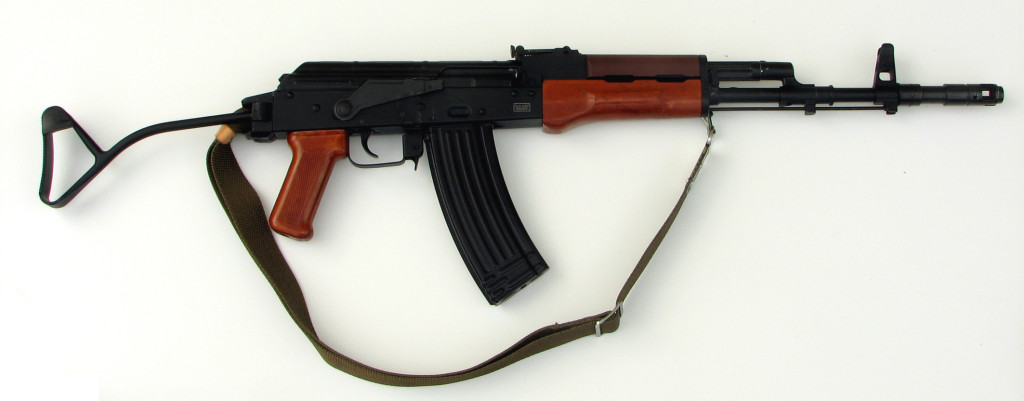
by Leszek Erenfeicht and Lt.Col. Dr. Mirosław Zahor
The American experience with the 5.56 mm assault rifle use during the Vietnam War, despite all the setbacks of the early M16 and M193 Ball, did aroused a great deal of curiosity and then desire to introduce similar weapon on the other side of the Iron Curtain. In the mid-1970s the Soviets have finally introduced another generation of the Kalashnikov rifle and LMG called the AK-74/RPK-74.
The Basic weapon of the new family, was the AK-74 rifle – a thoroughly modified AKM chambered for the new 5.45×39 mm caliber. The interchangeability rate between the AK-74 and AKM, despite the nearly identical appearance, is down to a mere 50% – and then limited to non-essential internal parts, like pins, retainers, screws, springs etc. Although the barrel length of 415 mm (16.3 in) was retained, the barrel itself was entirely new, designed from the scratch and non-interchangeable with the older model. So were the gas chamber (initially also fitted with an oblique gas channel, then changed to a perpendicular one) and front sight post with muzzle thread moved from the actual muzzle to the front sight base body, that the muzzle just poked through. Onto this increased diameter muzzle thread a completely new, complex, multi-functional muzzle device was screwed on, exchangeable for the blank-firing attachment.
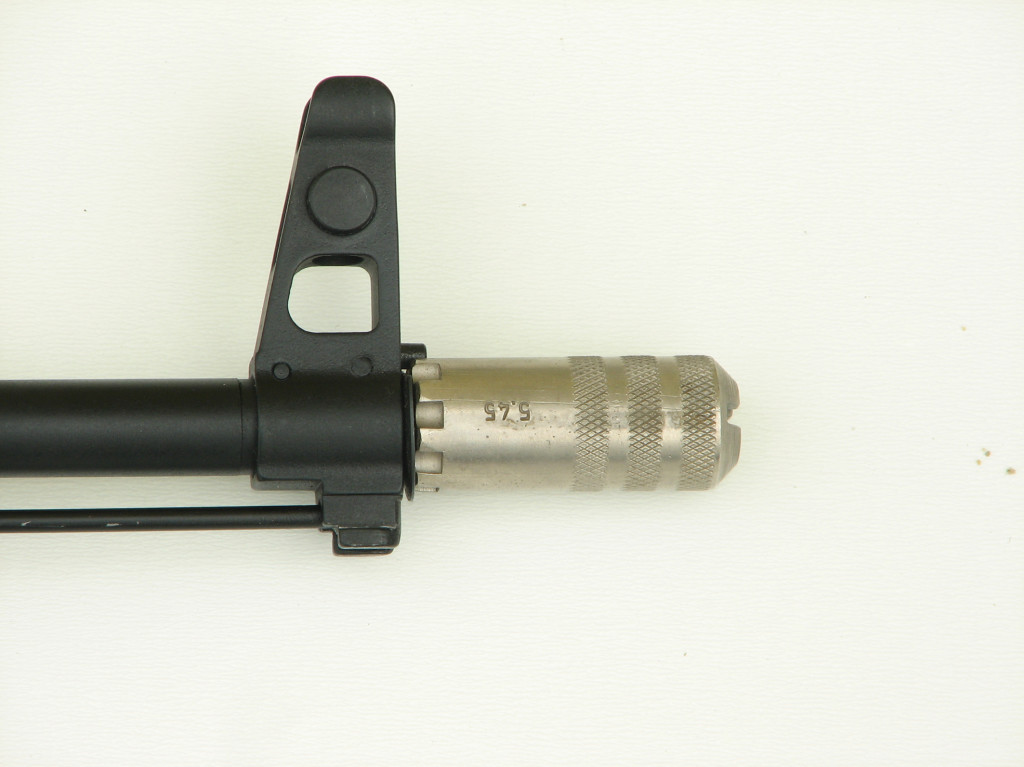
The muzzle device was the single most identifiable feature of the new rifle. It was a combined flash-hider, muzzle brake (single-baffle type side openings), and muzzle jump compensator, all rolled in one, with additional asymmetric holes drilled in initial expansion chamber, helping to stabilize the rifle in bursts. The receiver was also redesigned, with most changes concentrating within stock attachment, ejector and magazine well areas. The bolt carrier was also lightened, as was the bolt, plastic magazines were introduced, enabling stripper clip loading. In 1979, for the very first time, a compact model of the Kalashnikov rifle was introduced into the Soviet Army. The AKS-74U (in America also known as the ‘Krinkov’– for some obscure reason) took over most of the functions hitherto reserved for a submachine guns. The shorty carbine had a 206 mm (8.1 in) long barrel with front sight post placed directly on top of the gas chamber. Here also the muzzle device was being screwed onto the thread placed at the mouth of the gas chamber body/front sight base. This one is also a multi-functional device, consisting of the cylindrical initial expansion chamber culminating in a cone-shaped flash-hider. The new rear sight, a flip-over affair, was riveted to the top of the receiver cover, which was now hinged, machine gun style – rather than separate like in all other AKs, including the AK-74.
Tantalean Ordeal, a Prelude: Poland’s Bumpy Road to Small Arms Independence
Shortly after that, Poland along with all other Warsaw Pact countries started to prepare for the introduction of the new standard – a small-caliber individual weapon system. When Polish authorities inquired about the possibility to obtain the license rights for manufacturing of the AK-74, the price tag and export limitations were found outrageous enough to warrant a decision to circumvent the Soviets – and do it ‘my way’, as Frank Sinatra put it (using Paul Anka’s lyrics, btw). And so the decision was made: the Polish soldier of the future would wield a similar – but not the same – weapon. In order to achieve that goal, Polish designers undertook an ambitious task: to build a rifle at the same time identical to AK-74 – and completely different.
Fortunately, they did not have to start from scratch entirely. As early as 1973 the Warsaw’s Military Technological University (WAT) design team created a new intermediate round of improved ballistics, the 7 mm x 41, code-named ‘Marszyt’. The bullet had a trajectory peaking only 240 mm high at 300 m, leaving muzzle at 770 mps (2530 fps) – which given a 7.68 g (118 gr) mild steel-cored ball weight would give the muzzle energy in the 2200 Joule region. As of 1976 the Ośrodek Badawczo-Rozwojowy (OBR, or R&D Center) of the Radom’s ‘Works 11’ (known to all civilian scum as the ZM Łucznik Mechanical Works, country’s prime manufacturer of typewriters and sewing machines) undertook an ambitious task of creating a modular firearms system chambered for it, code-named ‘Lantan’. This modular weapon system was supposed to be based upon a common receiver, which by fitting different barrels, feed modules (magazine or belt) and/or stocks, would become a paratrooper carbine, an assault rifle, a designated marksman rifle, a light machine gun, a tank machine gun or a SAW-style machine gun (the two latter were belt-fed), just like it was the case with the Czech URZ or US Stoner 63 systems. Of course it was doomed from the start, for two reasons. One was obvious, objective in nature and common to all modular weapon systems of the 1960s and 70s: a short-barreled carbine with a sturdy machine gun receiver wasn’t the most successful combination, both weight- and economy-wise. The deciding factor was however, that the Soviet staunchly opposed to introduction of the 7 mm round, even though it proved to be a tack-driver with excellent penetration capabilities. Well, the Americans haven’t had a monopoly for the ‘Not-Invented-Here factor’.
Only two prototype rifles were ever manufactured, with a mere twelve thousand rounds of ammunition, mostly used up for testing. After Moscow said ‘Nyet’ to the Lantan project, two regular AKMSs were converted to 5.6 mm caliber, firing the early version of the Soviet small-caliber intermediate ammunition, the 5.6 mm x 39 Running Deer ‘sporting’ round. The 5.45 mm x 39 was then still a secret, jealously guarded from friend or foe alike. Testing the 5.6 mm AKMS of course lead nowhere – just like the Soviet testing of the AKM chambered for the same round ten years earlier, which led to creation of the 5.45 mm round.
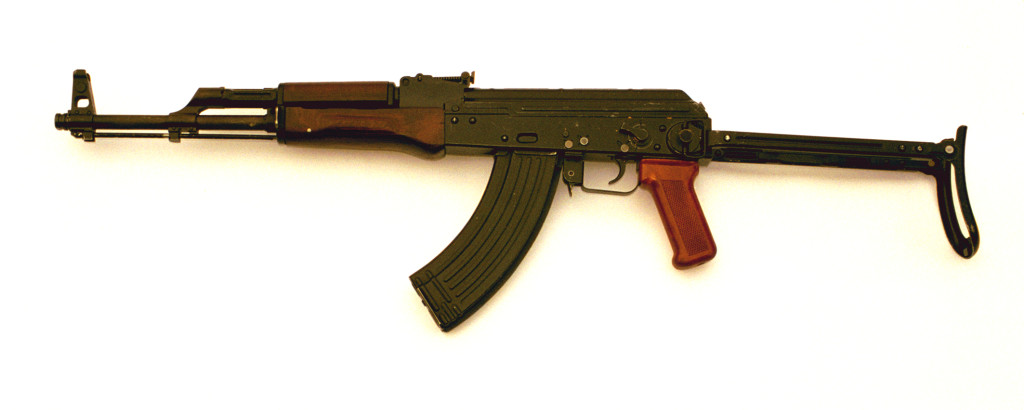
Then, in late 1970s, after the Lantan project was forcibly abandoned, Poles took another bid at improving the basic AKM ‘their way’, and designed the AKMS wz.80 (Model of 1980) with a three-round burst limiter. This three-round burst capability was one of the three ways tested then to improve the full-auto accuracy and hit-probability of the AKM. Two others were introducing a muzzle device similar to the one used in AK-74, and reducing the rate of fire, following the Japanese way (as in the Type 64 rifle). Polish designers took apart and studied three-round burst mechanisms of the French FAMAS, Belgian FN CAL and Swiss SIG 540, and choose the simple and sturdy Belgian ratchet as a pattern. The modernized AKMS rifle fitted with three-round burst mechanism was designated AKMS wz.80 – but never introduced into the inventory of the Polish Army. It differed from the original AKMS by having fire-selectors entirely separate from the safety function – even though combining them into one large side lever on the right side of the receiver was a salient feature of the original Kalashnikov design.
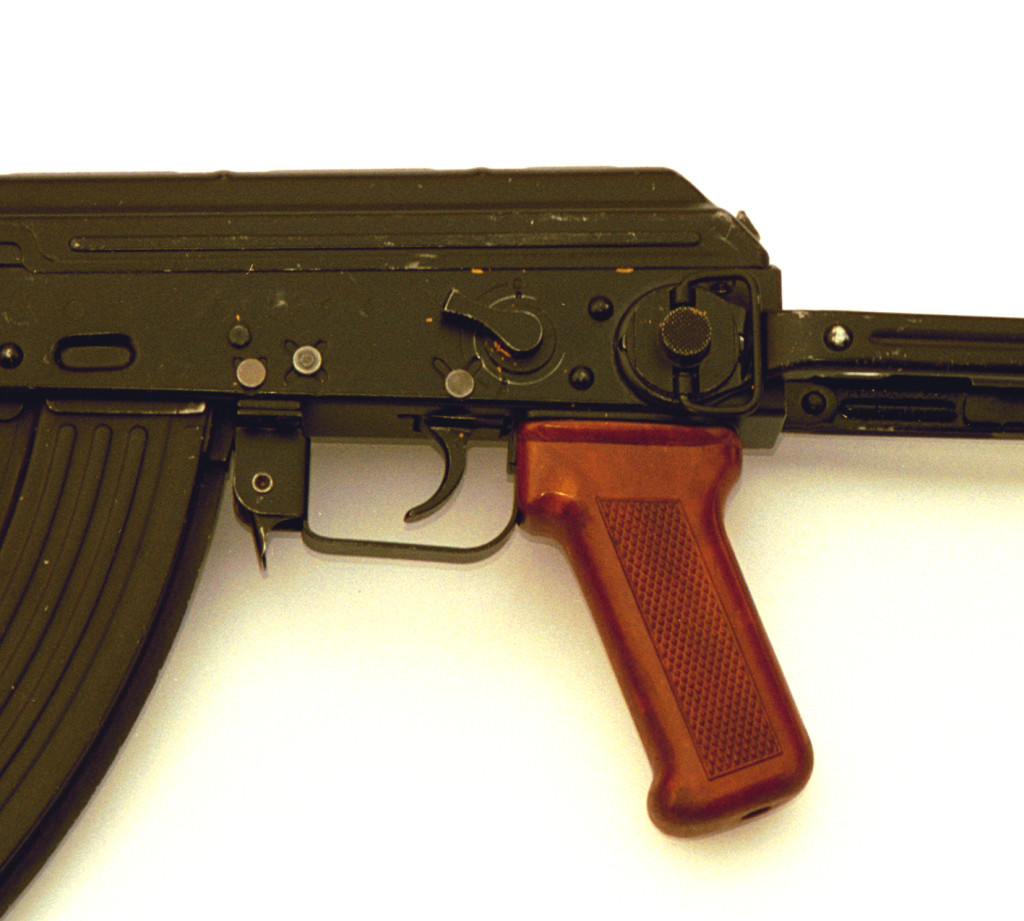
The Polish AKMS wz.80 was different in having a separate safety lever on the right side, looking just like the original safety/selector, but right now with just two positions left – upper, safe (‘Z’ for Zabezpieczony) and lower fire (‘O, for Odbezpieczony), instead of the original three (usually unmarked ‘Z’, ‘C’ – for Ciągły or fully-automatic and ‘P’ – for Pojedynczy, or semi-automatic). The fire-selector function was moved to a separate lever on the left side of the receiver, with three positions: ‘C’, ‘S’ (for Seria, or burst) and ‘P’, in counterclockwise order. The trigger lacked the typical AKM rate reducer, and the semi-auto sear had a pin protruding out of it to cooperate with the burst limiter’s toothed arc. A burst-firing mechanism pack was added on the left inner side of the receiver. The actions of putting the rifle on safety, off safety, and shooting semi-automatically, were identical to the old milled receiver AK-47 without a rate reducer. If the fire-selector was set to ‘S’, the semi-auto sear was held back by the two-toothed arc, set in motion by the hammer movements. After the third shot was fired, the ratchet no longer held the semi-auto sear, which is then freed to snap into place and catch the hammer. The firing ceases exactly like in semi-automatic fire. Upon releasing the trigger, the mechanism resets itself and the toothed arc snaps up against the semi-auto sear’s protruding pin, ready for another three-round burst. Unlike in American three round mechanism of the M16A2 / M4, if the firing ceases after just a shot or two, the next burst would always be a full three rounds long. Moving the fire-selector lever to the left side of the receiver necessitated a slight undercut in the left folding stock strut to clear the lever while folding underneath the receiver.
Thus the stage was set: after two Warsaw Pact armies (East Germany and Bulgaria) were forced to bite the bullet and purchase the pricey AK-74 licenses, Poland took the bumpy road, deciding to design their own cartridge (codenamed project ‘Cez’) and the new rifle – an indigenous circumvention of the AK-74, codenamed project ‘Tantal’.
Tantalean Ordeal, Act One: Turning AKM into AK-74 ‘My Way’
The initial studies on the 5.45 mm Polish rifle were undertaken at the Radom factory’s OBR R&D Center as early as spring of 1980. The AK-74 was an obvious choice for a pattern, but Polish designers wanted their rifle to retain a much higher degree of interchangeability with the AKM and use the freshly designed three round burst limiter of the AKMS wz.80. The receiver of the AKM (in America frequently mislabeled as a ‘stamped receiver AK-47’ – such animal simply doesn’t exist!) was modernized only in the necessary degree, with ejector lengthened enough as to reach the much narrower bottom of the case. Another change was the new sight base, necessitated by the re-designed gas tube and upper handguard, eliminating the previously used gas tube latch on the rear sight base. The new gas tube latch was fitted to the opposite end of the gas tube, on the handguard ring. The new gas chamber had a perpendicular gas opening and a front sleeve around the barrel, where a bipod was attached. The moving parts consisted of the lightened AKM bolt carrier and a modified bolt, with smaller diameter bolt face and open-sided extractor cutout (patterned after the AK-74). The brass hats envisioned fitting each of the new rifles with a rifle grenade capability, with new generation bullet-trap rifle grenades. At the same time, the new rifle was to be fitted with folding stock only – and that meant that the traditional bottom-swinging folding stock of the Kalashnikov rifles had to go. The sheet-metal stamped and riveted struts of the AKMS stock would never be able to withstand the level of recoil generated by rifle grenade firing. In the late 1950s experiments with AKS (‘milled AK-47 under folder’ if you like) fitted for rifle grenades throwing proved that even the older pattern solid bar stock struts were giving way. So the new rifle had to be fitted with a new, more durable pattern of the central-strutted stock. The East German MPiKMS-72 was chosen as a pattern, with it’s simple loop-stock, derisively nicknamed a ‘Pogrzebacz’ (Ash-Poker) by the Polish soldiers.
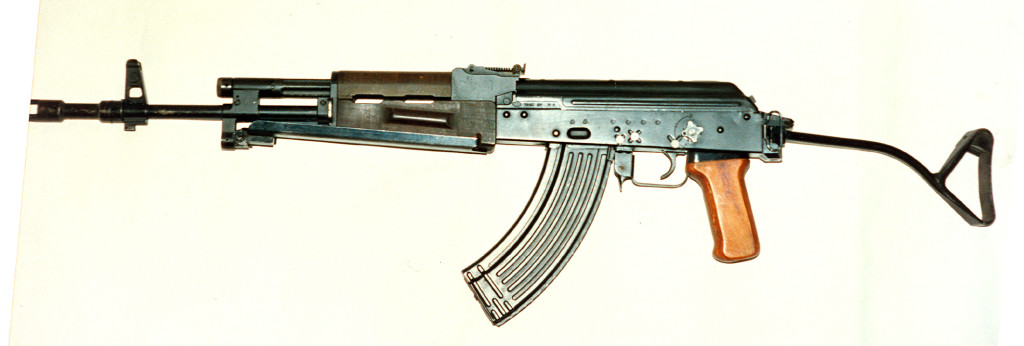
The Tantal stock hinge is fitted to the receiver by lieu of the upper screw and the pistol grip screw, going through the flat spring of the stock latch. The entire folding stock hinge can be thus replaced with an AKM wooden stock, if need be. The only wooden stocked Tantals ever to be assembled, however, were those illustrated in a manual and weapon training wall chart. The Tantal was never manufactured nor used in such configuration. The flat latch spring at the same time acts like hinge brace, and is a significant simplification over the GDR model (with separate wire spring), making the Polish design distinct, and not just a copy. The handguard and gas tube retaining ring, as well as the upper handguard and gas tube itself were a significant departure from both AKM and AK-74. The retaining ring latch is a crossbolt with a cutout, rotating in a perpendicular groove on top of the barrel. Each time the gas tube is to be removed for cleaning, the latch bolt has to be rotated, so that the cutout clears the barrel and let the ring be slid forward, freeing both handguards. The ‘kbk wz.81’ (Model of 1981 Carbine – in Polish military parlance all intermediate round chambered rifles regardless of caliber and barrel length are ‘carbines’) earliest variant of the Tantal had a screw-driver slot in the latch bolt. This defied the common sense of making field-stripping as easy as possible without the use of tools, in order not to discourage the soldier – who has many more immediate problems in the field – from cleaning his rifle. Later on the screw slot was replaced by a lever extension. Unlike AK/AKM, the Tantal’s upper handguard is not fixed to the gas tube. The gas tube is a separate part, wedged between the gas chamber flange and rear sight base, then topped with a plastic upper handguard, doubling as a gas tube retainer, which in turn is held by the handguard retainer ring. This unusual feature’s sole reason was to enable the lower handguard dismounting without the field-stripping of the rifle – this was in turn required by the underbarrel wz.74 ‘Pallad’ 40 mm grenade launcher, mounted on the special mounting jig, replacing the regular handguard. This has to be seen as bizarre at least, making field-stripping of a rifle unnecessarily complicated only to facilitate mounting of an accessory issued at a one-per-squad basis, and never mounted or dismounted in the field!
In late 1981, with mounting political and social unrest in Poland in the last phase of the Martial Law preparation, the Tantal development program was suspended.
On Sunday, December 13, 1981, in the wee morning hours the military took to the streets, as the Polish Communist Party crushed the Solidarity labor and pro-democracy movement, putting an end to the 16 months of the ‘Freedom Carnival’ started by the Gdansk Shipyard strike, and Lech Walesa’s meteoric rise to fame and power. For a year and a half, until July 22, 1983, the country virtually ground to a halt, with curfew, cut – then tapped – telephones and military patrols in the streets, punctuated by epic Solidarity demonstrations, ruthlessly suppressed with water-cannons, rubber batons and tear gas by the infamous ZOMO riot police.
Radom’s Works 11, itself a hotbed of Solidarity and the scene of the former 1976 workers’ riot that led to a creation of the organized political opposition in Poland, was certainly not a secure place to develop a new weapons system for the Communist regime. Nevertheless, the 5.45 mm program continued on, and Skarzysko-Kamienna’s Works 21 ammunition plant (a.k.a. ZM Mesko, lawn-mower and coffee-grinder manufacturer) finally mastered the tricks of the 5.45 x 39 mm ammunition manufacture in 1983. After the first experimental batch was tested positively, the ammunition source was at last secured, eliminating the need to buy it from Soviet Union. In 1984 the Ministry of National Defense’s Office of the Chief of Military Technology Research and Development issued an order for ‘developing of the 5.45 mm automatic carbine’, for which in 1985 the Technical and Tactical Requirements document was issued. The new rifle was to be of ‘comparable measurements’ with the AKMS, and not heavier than 3.3 kg (7.3 lbs). It was to fit into the existing firing ports of the armored vehicles (e.g. the BMP-1 infantry fighting vehicles, or the 2S1 Goździk self-propelled amphibious 122 mm gun-howitzer) as well as standard AKMS rifle racks installed in all military vehicles and barracks.
The Acceptance Requirements did not deviate much from the standard AKM procedures. A minimum service life of 10,000 shots was required, including 150 shots with 300- and 500-gram rifle grenades. The reliability objective was set at 0.2% jams (or 20 malfunctions in entire service life of 10,000 shots). The required accuracy was an extreme spread of a 5 round group, shot from a rest, prone, semi-automatically, at 100 meters to fit within 150 mm (5.9 inch).
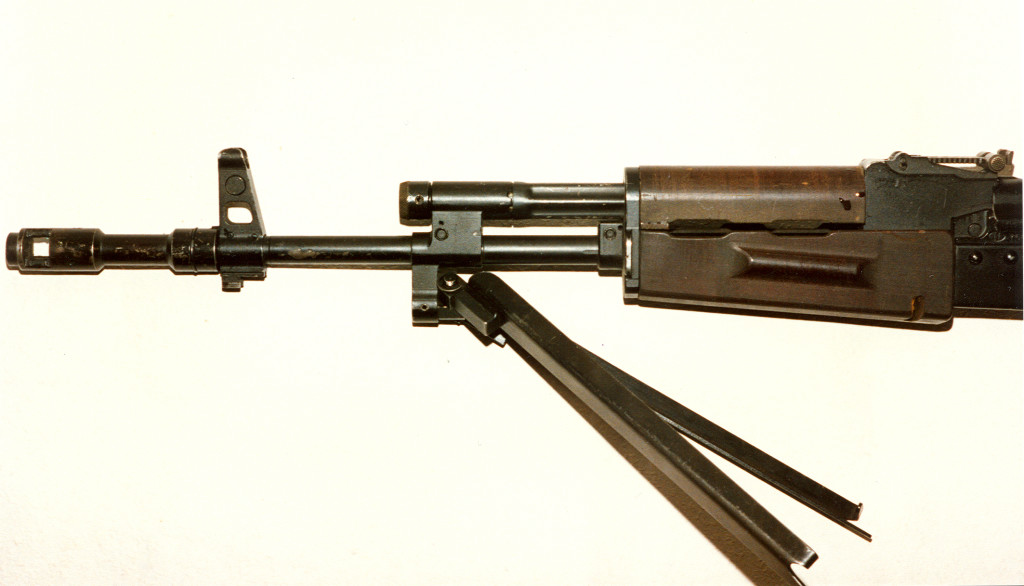
The initial batch of the wz.81 Tantals was sent out for testing in 1986 – and flopped terribly, missing its chance to be introduced into the inventory of the Polish Army. The original test report is still confidential, so one cannot state what went wrong. Some things were obvious then: the length of the rifle with stock folded was too long for standard AKMS racks, which would necessitate rebuilding all existing racks built into each and every military building, truck, car, or armored fighting vehicle – thus the next model was shortened. The magazine was another problem. The one used with Tantal wz.81 had a top part taken directly from AKM, which enabled to attach a wrong magazine loaded with 7.62 mm x 39 rounds to the rifle – while the Soviet AK-74 magazine could not, which prevented interoperability in the future liberation of the Western Europe.
Tantalean Ordeal, Act Two: the Great Rifle Grenade Folly
Polish Army was the first, and despite occasional experiments in other ComBloc countries, the only Warsaw Pact military to design, manufacture and field rifle grenades in any quantity. Polish rifle grenades were fired with a special grenade blank UNM wz.43/60 from a 20 mm outside diameter grenade spigot screwed onto the muzzle thread of the specially modified wood-stocked milled receiver AK, called the ‘karabinek-granatnik wzór 1960 (kbkg wz.60)’, or carbine-grenade launcher Model of 1960, with a specialized variant with detachable wood stock, the kbkg wz.60/72 for airborne troops (only 500 ever made). During the 1970s, taking the cue from the US Army, the kbkg wz.74 AKM rifle with Pallad 40 mm underbarrel grenade launcher chambered for the 40 x 47SR mm fixed rounds, was designed to replace the rifle grenades once and for all. The rifle grenades were criticized by the military as awkward to handle, kicking like a mule, and dangerous in the event of failure to clear weapon properly before ammunition change (from live to grenade blanks) prior to firing of the grenade. With a failure to clear the rifle, a live ball could be left in the chamber and grenade would detonate on launching, if struck by the bullet. Several such incidents did occurred, both in training with the Polish Army, and in combat, when Polish rifle grenades were fielded by the North Vietnamese Army and the Palestinian Liberation Organization.
All militaries of the world were transferring from the spigot-fired rifle grenades to the 40 mm (or so) barreled grenade launchers for anti-personnel work and shoulder-fired RPGs for anti-tank defense, as the AT rifle grenades were long ago insufficient against thick-skinned opposition. Tactical-grade commanders all knew that, and reported it to their superiors, but the higher brass of course knew better and insisted on having a new generation of the rifle grenades, with bullet trap, fired with a live ball round. A whole new design program was started, codenamed “Fosforyt”, to create these. As the energy of the small-caliber intermediate round was no match for the specialized grenade blank loaded with as much as 2.5 gram of the fast-burning P-125 powder (as opposed to 1.67 gram of the VUFL powder for a 7.62 mm x 39 ball round), the new grenade had to have increased inner diameter, to give the gases more area to push against when firing. The tailboom of the new grenade was thus of the 30 mm inner diameter (as opposed to 20 mm in kbkg wz.60). This in turn necessitated a 30 mm sleeve on the world standard 22 mm wide multirole muzzle device. This sleeve was deemed an integral part of the rifle – to the extent of turning down it’s muzzle end to accommodate the 6H4 AKM bayonet cross-piece ring. The early sleeved muzzle device can be identified by having three perpendicular grooves on the outside surface, as opposed to the later model one, much wider groove.
Tantalean Ordeal, Act Three: Too Little, Too Late
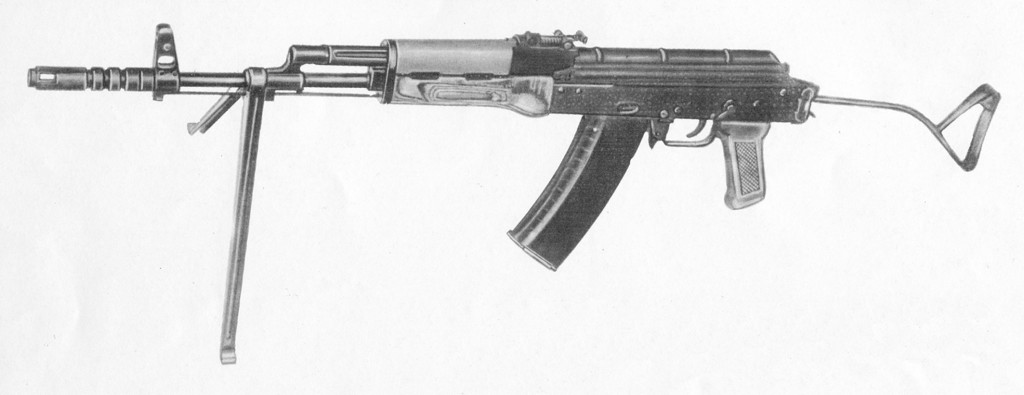
The improved and partly redesigned (AK-74-compatible bolt carrier, bolt and magazines, shortened to match the AKMS overall length) prototype Tantal was factory-tested by the end of 1987. A prototype batch of two was sent back for military testing, which took place between March and June, 1988. Both rifles had still utilized Soviet magazines (early orange plastic ones) and had wooden forends. Tantals were tested against the AKMS and Soviet AK-74, firing the Polish-manufactured 5.45 mm PS ball ammunition and Soviet 7N6 tracer. Fifteen thousand rounds were pumped through the first prototype, and in excess of 20,000 through the other, proving that just like the AKMS, the new rifles had much more service life in them than the 10,000 shots required and expected. The dummy 350 g rifle grenade was clocked at 53 mps, giving it a 210 m range, a little short of the expected 250 m. The heavier 500 g grenade achieved respectively 46 mps velocity and 180 m effective range. During the test several drawbacks were noted, especially while firing rifle grenades, e.g. increasing play of the barrel mounting block inside the receiver, falling off of the receiver cover as well as excessive, and increasing still play of the folding stock hinge. Modifications were ordered to remedy these, and the 30 mm sleeve was ordered to be removed from the muzzle device, made disposable, manufactured of plastic and incorporated inside the grenade’s tailboom.

The improved rifles were again tested early in 1989 and finally found fully compliant with the requirements, so the initial batch for troop testing was ordered and in 1990 actually handed over to the Army for troop testing. In 1991 the 5.45 mm rifle came into series production and was introduced into the inventory of the Polish Army as the ‘5,45 mm karabinek wz.1988 (kbk wz.88)’, officially dropping the R&D-phase codename of Tantal – even though it persevered as the popular name of the firearm.
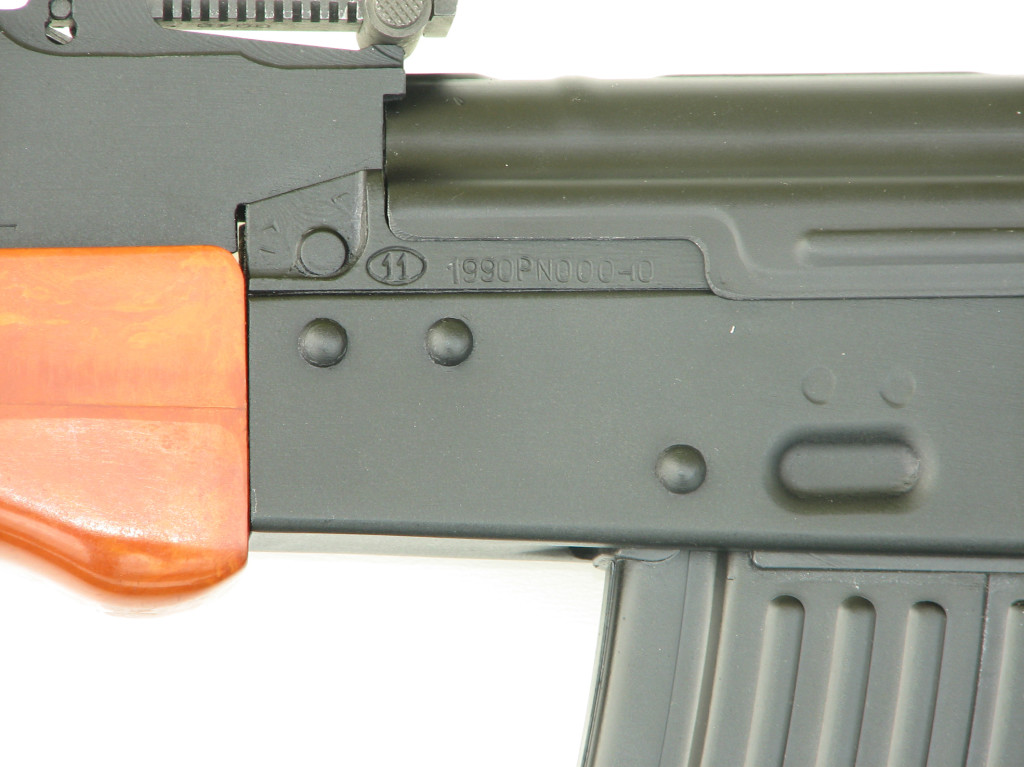
It was however all too little and too late, as the November 1989 ‘Fall of the Nations’, set into motion by Poland’s June 1989 power changeover, swept Communist rule from Central Europe almost overnight after 45 years of Soviet dominance. In Poland, Solidarity resumed semi-legal activity in 1988, then it was re-registered and subsequently, Roundtable talks with the Communists led to a peaceful change, following the June 4, 1989 landslide victory of the Solidarity movement in the country’s first post-WW2 free election. Just as the Tantal was ready for series production, it suddenly became redundant, after Poland opted for full integration with the West and future membership in the NATO. With plans like these, a brand-new rifle firing Warsaw Pact ammunition was just useless, and the Tantal was dropped in 1994, after just a couple dozen thousand were manufactured.
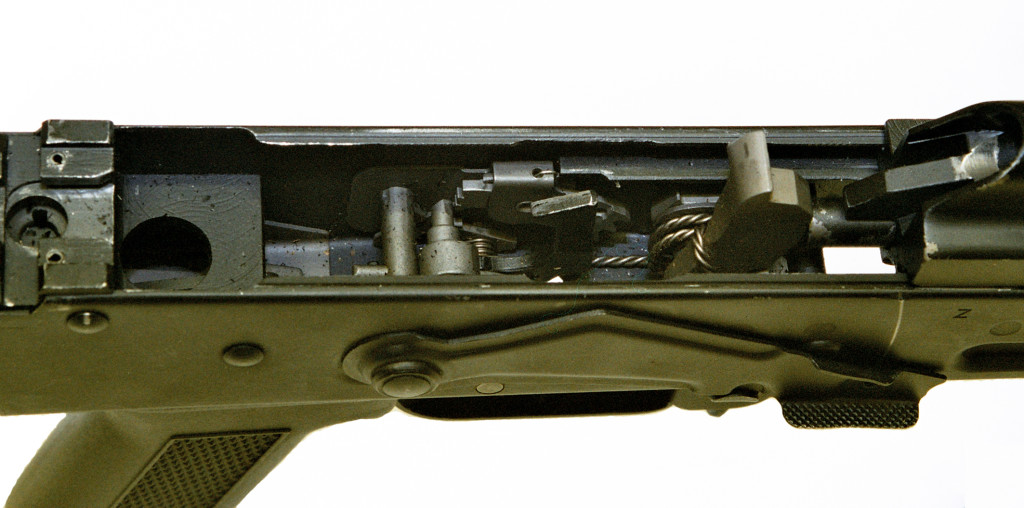
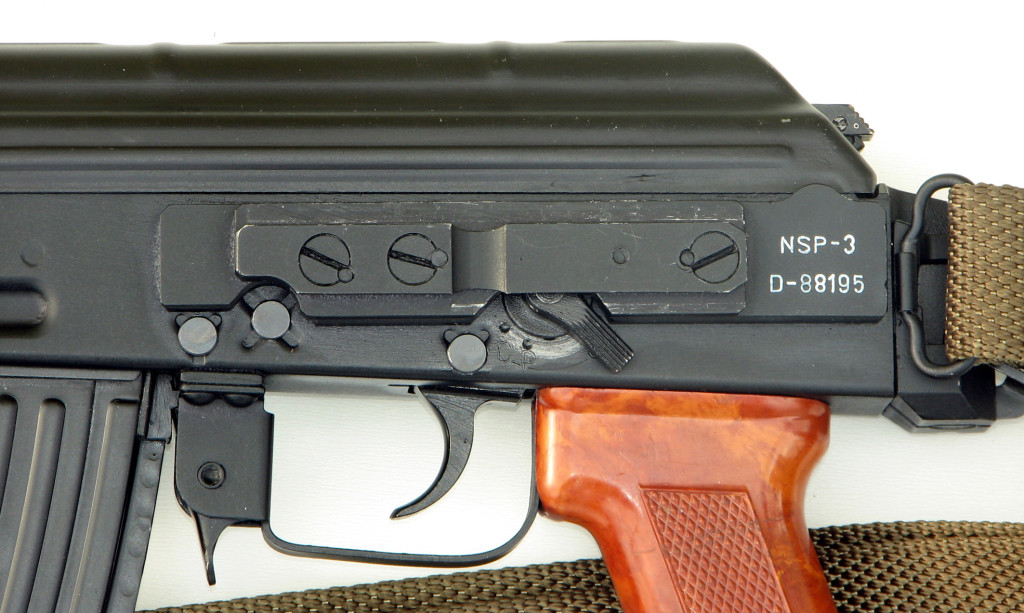
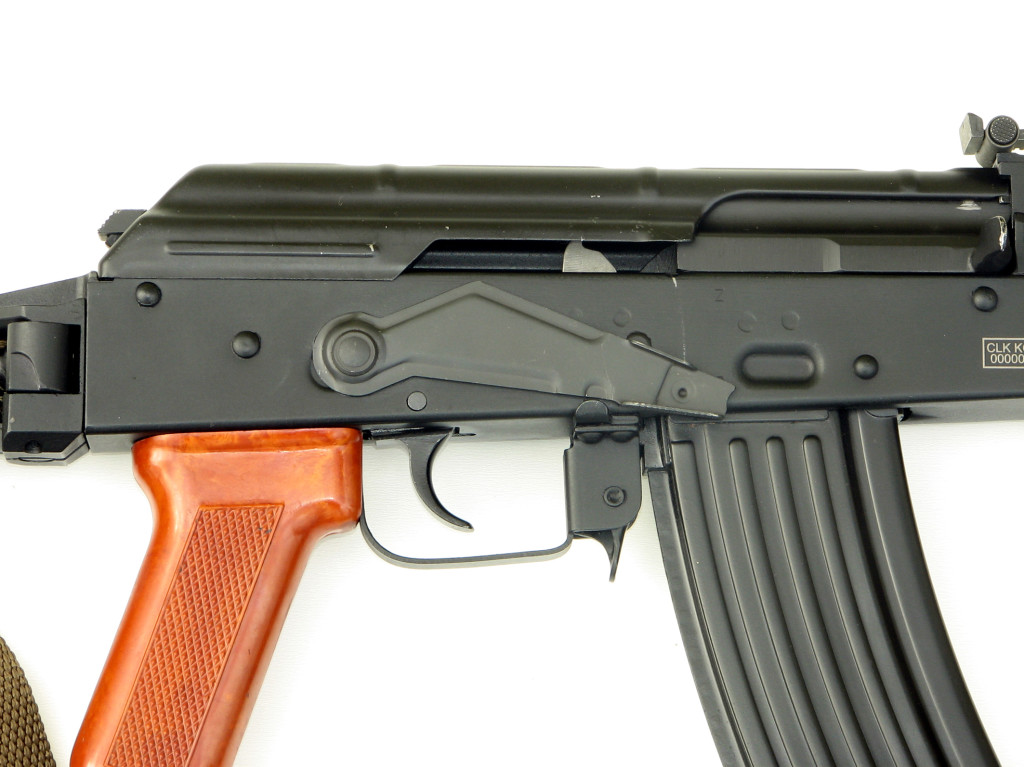
Even over this short span of the production period, numerous design changes were introduced. The trigger mechanism was modernized, replacing the AK-style one-piece hammer-and-trigger spring with separate trigger and hammer springs. It gave one part more to detach during detailed stripping, but putting it back together was thus simplified – now the hammer spring could be set on the hammer, short loose ends rested against the bottom of the receiver, and after the hammer pin was reintroduced, the hammer group was ready to work. This reduced the time and effort needed to put the rifle back from a detailed strip, without the need to ply the long loose ends around the various trigger mechanism’s pins and bits. (BTW – only Soviet and Polish operator’s manuals trusted soldiers with detailed stripping procedure of the rifle; all other Warsaw Pact OMs only dealt with field-stripping for cleaning, reserving detailed stripping for the authorized repair personnel only). Other changes included fitting a lever extension, instead of the screwdriver slot to the forend ring retaining cross-bolt, thus eliminating the need of tools for stripping. The finger extension was carried-over from the late series Tantal into the 5.56 mm successor, the Beryl. Another change was mostly of cosmetic nature – orange and tan (generally, but ranging from yellowish to deep brown) furniture were later-on unified to flat black plastic, giving the rifle a much more uniform and serious look. The new-style black lower handguard was AK-74M-style ribbed, to improve grip. Similar black plastic furniture was also developed for the Onyks shortie.
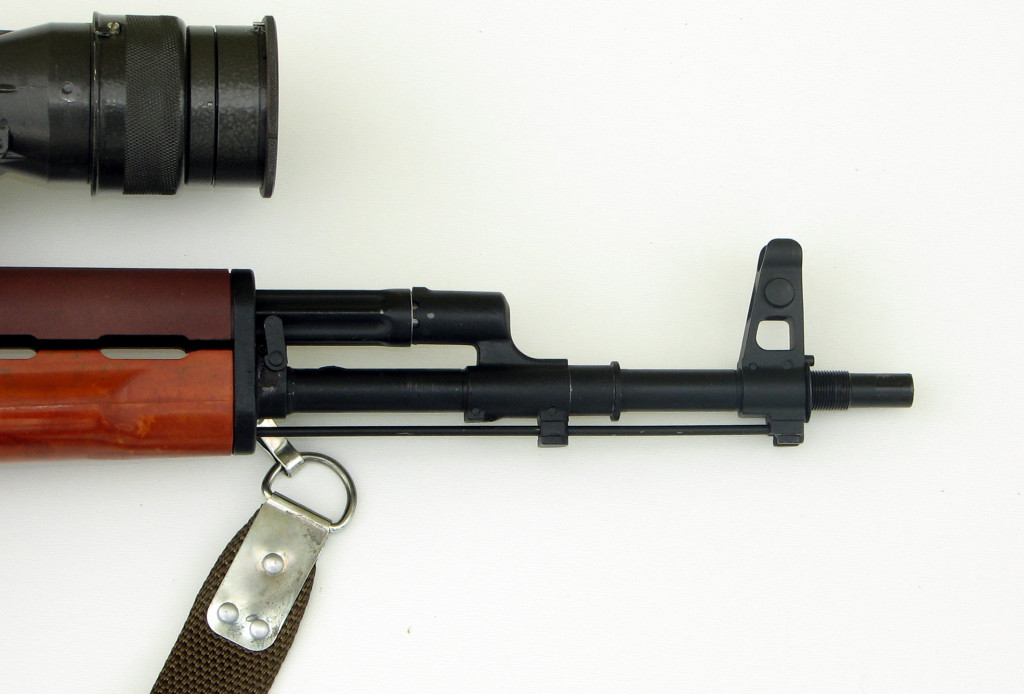
At the same time the long-time magazine supplier to the Radom Works 11, a company from Łódź called Wifama, had gone bankrupt and the Radom factory had to introduce their own plastic magazines instead of the hitherto sheet-metal ones, used for AK, AKM and Tantal. Bodies and followers were molded out of the black glass-fiber reinforced polyamide, which reduced their weight and price significantly, at the same time improving their reliability and mechanical resistance. The Tantal design is protected by the Polish patent PL 160959 of 1993, issued to Krzysztof Styczyński, Bohdan Szpaderski and Bogusław Białczak.
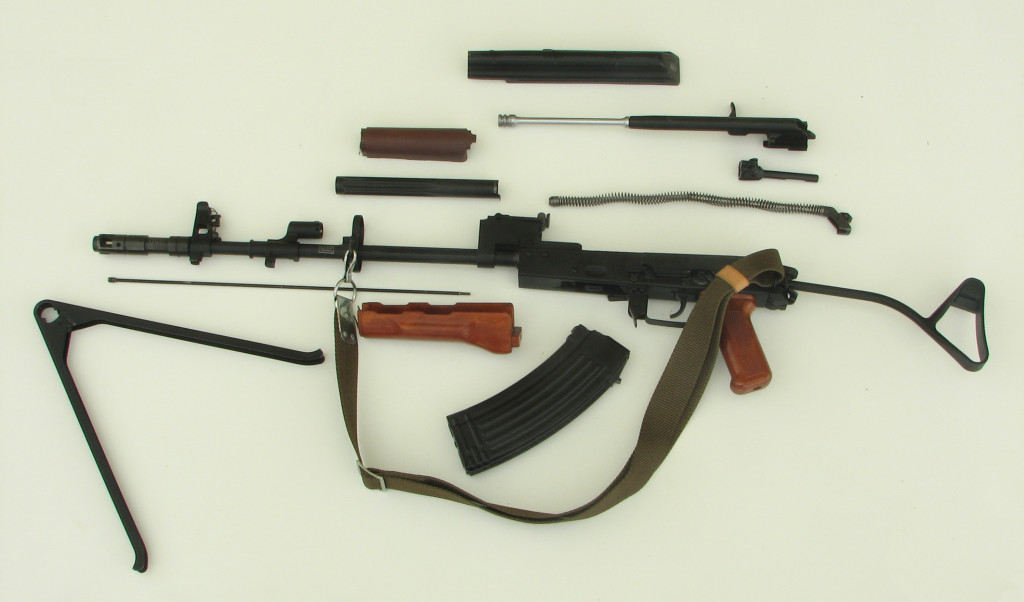
5.45 mm wz.88 rifle is an automatic, gas-operated weapon with long-stroke piston. The bolt turns to the right for locking. Automatic sear prevents a discharge before the bolt is fully locked. Ammunition is fed from a 30-round staggered-column, alternative-feed, curved box magazine, initially of full-steel design, then with plastic body and follower. Open, mechanical sights comprise a tangent rear sight with a U-shaped notch, for firing at the distances 100-1000 meters in 100 m increments with a fixed battle-sight position ‘S’, enabling a torso shot up to 440 meters. The front post sight is of the typical AK design – set on top of the high A-shaped carrier, inside the slider for windage setting and can be screwed in and out for elevation. Tritium night sights are standard on all rifles. NB – it was Poland that pioneered radioactive tritium lit sights on the eastern side of the Iron Curtain: all other Warsaw Pact countries from USSR down, used just phosphorous paint for night shooting. The rifle has a right side folding monostrut stock, enabling firing and reloading of the weapon with the stock folded.
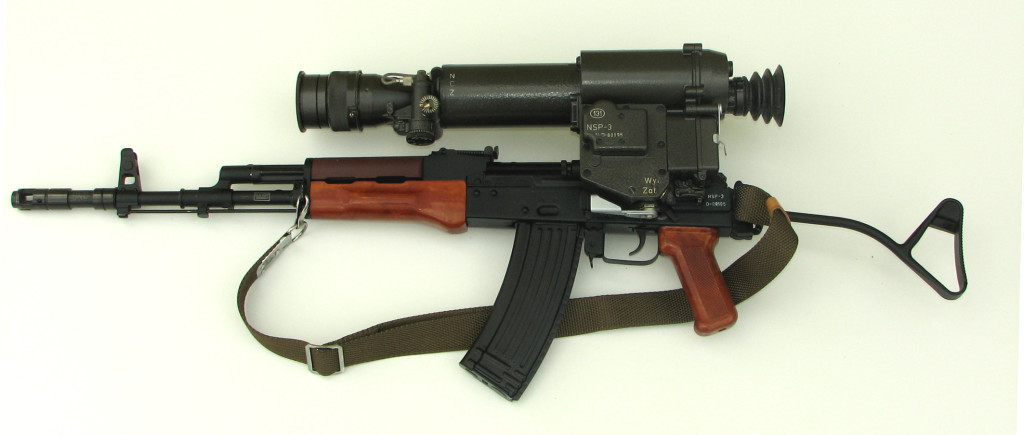
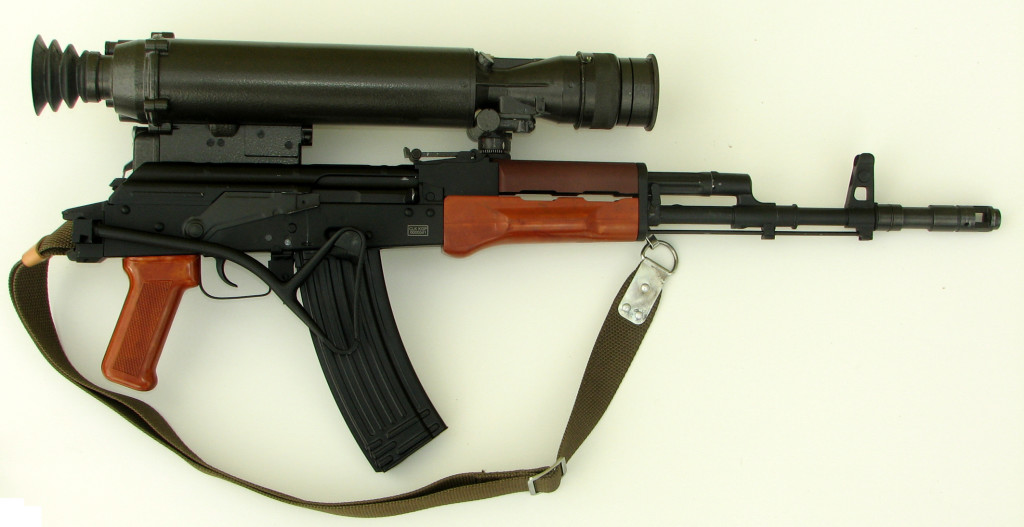
There were two weapons developed from the wz.88 Tantal – the wz.89 Onyks carbine, and the 5.45 mm kbkg wz.74, or Tantal with a Pallad 40 mm grenade launcher. A limited series of the very early series-produced Tantals were fitted with a mounting rail on the left side of the receiver, meant for the NSP-3 and then for the indigenous Polish improved NV sight, the PCS-5 Gabro from Warsaw’s PCO company. Fitting these rails impaired the function of the fire-selector lever, which extended only 2-3 mm past the edge of the deployed NSP-3. It was also planned to use this version as a DMR (designated marksman rifle) by fitting a GDR-manufactured ZFK 4×24 optical sight, utilized with the similar night variant of the East German license-manufactured rifle, the MPi-AKS-74N. Nothing transpired out of it, as the GDR was re-unified with West Germany before any quantities of the sights were delivered.
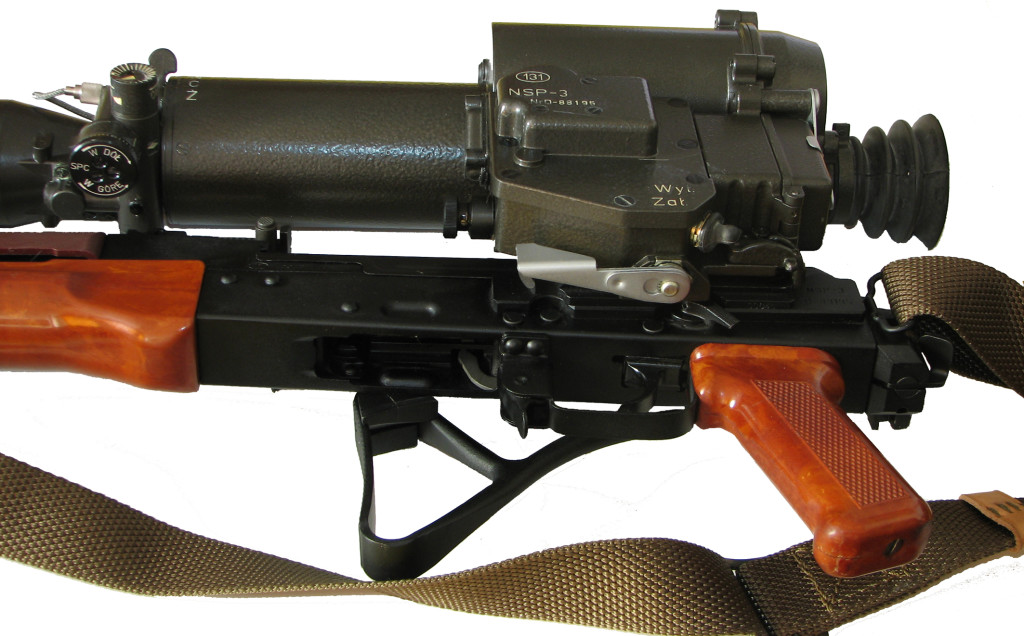
Even with all the changes made to barrel, muzzle device, stock, bolt carrier and bolt, return spring assembly, trigger mechanism, magazine, gas tube and forend the wz.88 Tantal is still more of an AKM, than the AK-74.
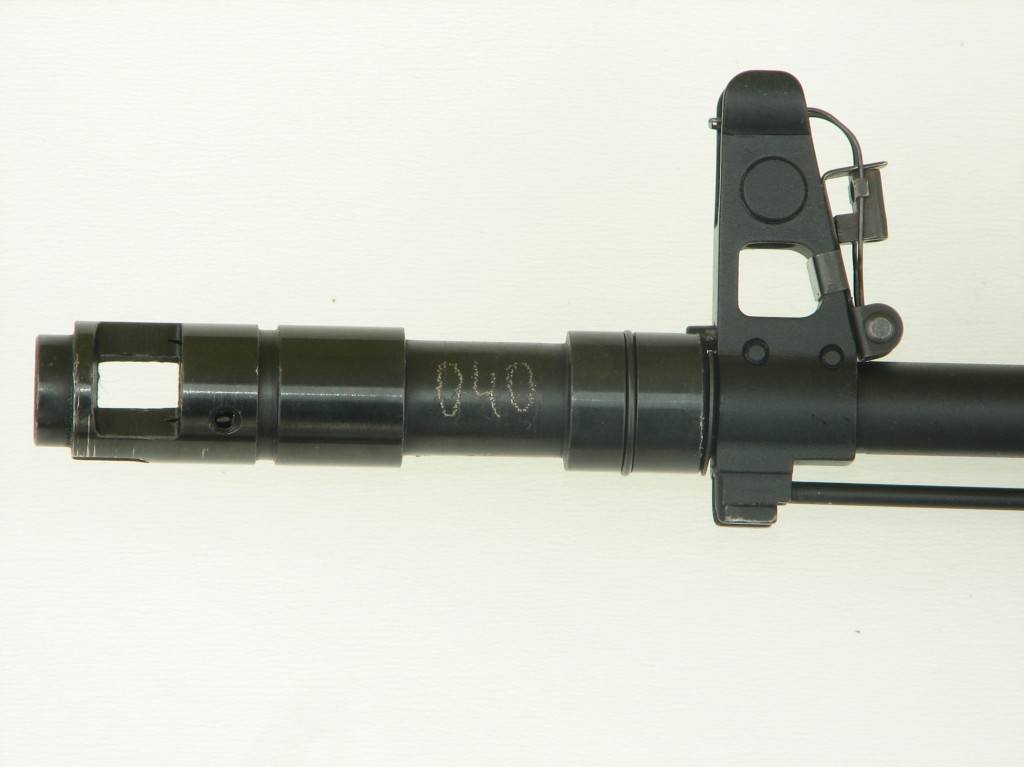
The 425 mm (16.3 in) long barrel is cold-forged, hard-chromed, with 4 RH grooves of 200 mm (1:7.9 in) pitch. The multi-functional muzzle device has an external diameter of 22 mm to exclude fitting an old style rifle grenade without bullet trap. The initial expansion chamber of the device has got three openings drilled through, 120 degree one of the other. Polish muzzle device is much longer than the Soviet, as it also doubles as the rifle grenade spigot. The initial wz.81 Tantal had an integral bipod, but after it was nearly broken off by the recoil of the rifle grenades shooting, a new detachable bipod was fitted, patterned after the M16 ‘clothespin’. This is being fitted to a special sleeve incorporated into the gas chamber body, with cleaning rod (carried the usual AK way under the barrel) inserted into a special opening of the bipod serving as a tilt stop.
The single-strutted stock is folding to the right, along the right side of the receiver. The stock strut has its rear end hammered flat, then folded into a triangular buttstock, with a rubber block inside the upper corner to avoid scratching the receiver side. The stock hinge latch, enabling folding of the stock, is placed on the left side of the stock hinge assembly and doubles as the stock retainer in both positions. One has to depress the stock latch with one hand and only then fold or open the stock strut with the other. To avoid loosening of the receiver cover, which was a commonplace during the rifle grenade firing, a manual latch was added to the return spring guide, borrowed from the kbkg wz.60, enabling to lock the cover after the rifle was put back from a strip.
Tantalean Ordeal, Interlude: a 5.45 mm Onyks wz.89 Carbine
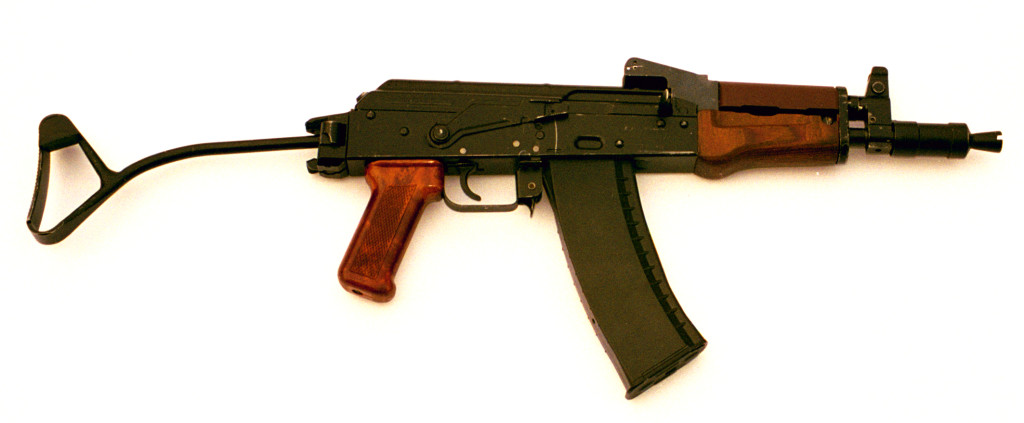
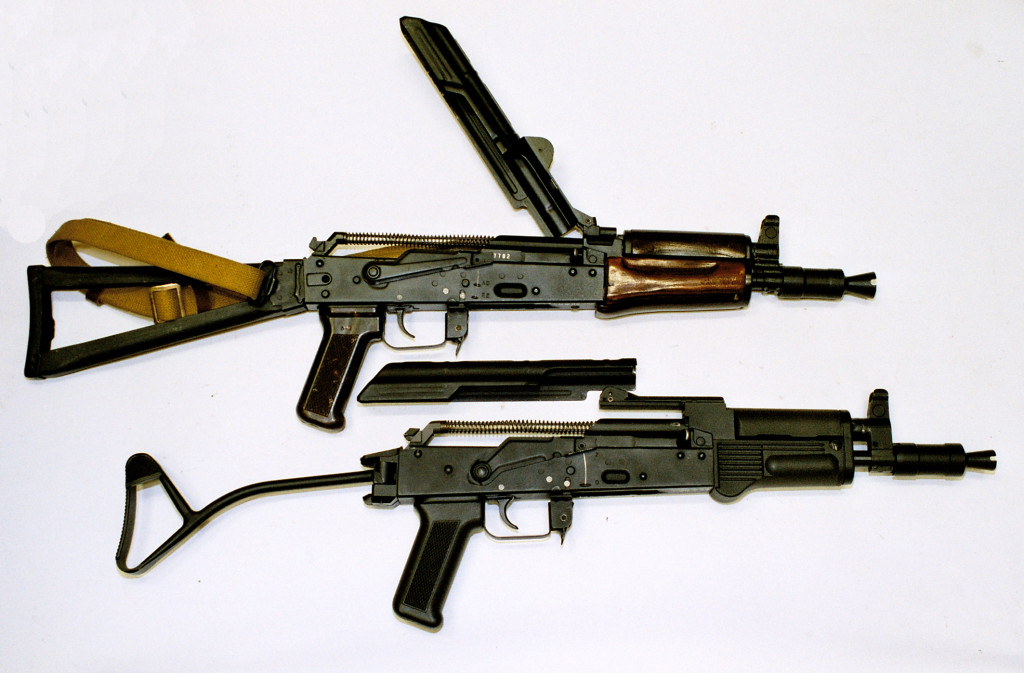
After the wz.88 Tantal rifle was ready in late 1987, the OBR team started designing of the compact version, a Polish clone of the AKS-74U. In late 1990 the first prototype was ready for testing, which took place in early 1991. The tiny carbine passed the tests with flying colors, but then a decision was made to fully unify the receiver with the rifle, which necessitated a thorough redesign, as the first prototypes had a Krinkov-style hinged receiver cover. The redesign took a while, and it only reach series production in 1992 – to be discontinued after a mere 200 were made. Officially it was rejected by the Army because the flash-hider was not efficient enough, but it was the politics that really polished it off, along with the older brother. Earlier on two prototypes of the 7.62 mm carbines based upon AKMS met with the similar fate.
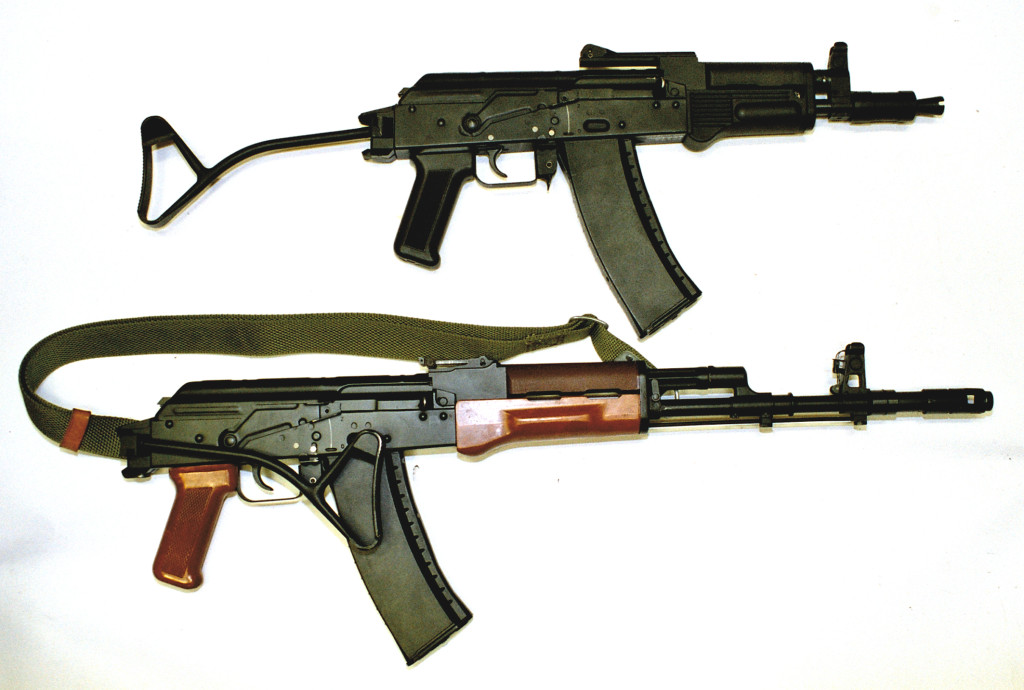
The ‘5.45 mm subkarabinek wzór 1989 (subkbk wz.89)’ is basically a chopped-down Tantal. The chop-job improved the handling abilities at the expense of the shorter barrel, bayonet and bipod. Strangely enough, the carbine retained the rifle grenade capability though, being the world’s one and only rifle-grenade capable shortie! The Onyks has many more parts common with the standard rifle than the AKS-74U. The barrel length was reduced to 207 mm (8.15 in), also the gas tube and both handguards were chopped – but the latter are still retained with the same retainer ring, fitted with the old style slotted crossbolt, even though the Tantal has already upgraded to a finger lever. The Onyks’ gas chamber is a copy of AKS-74U’s one, with muzzle thread at the cylindrical portion of the front sight base body. A muzzle device doubling as a grenade spigot or BFA can be screwed onto that thread.
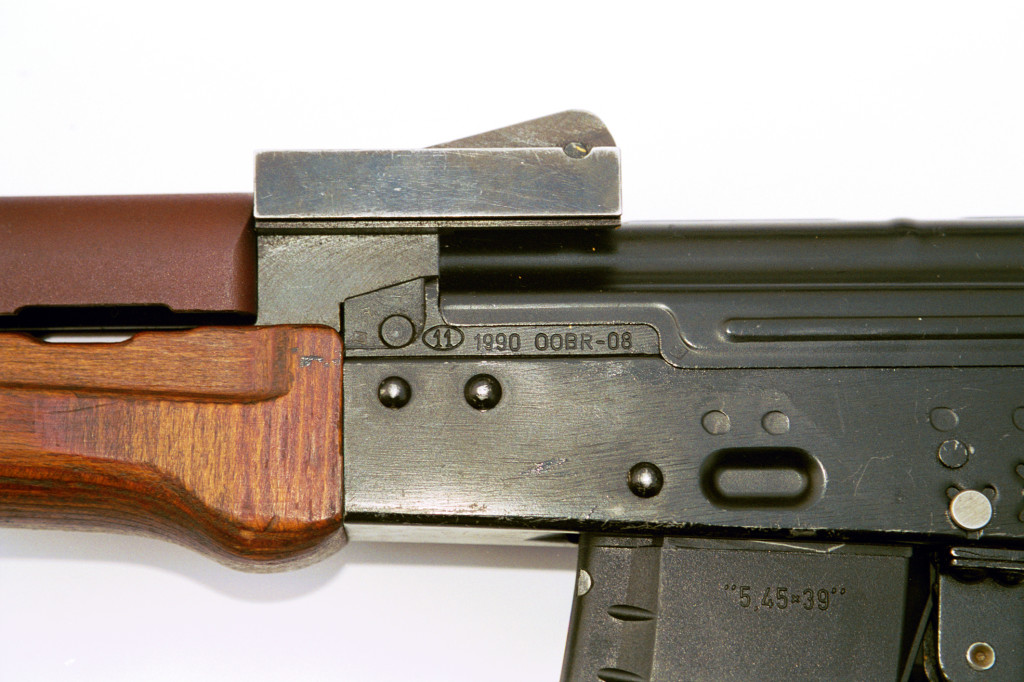
The rear sight base of the Onyks is of an original design. The first prototypes had an AKS-74U ear-protected flip-over rear sight and a likewise hinged receiver cover. A decision was made, however, to unify the receiver and discontinue the hinged cover, replacing it with the ordinary detachable one, like in full-length Tantal. To retain the proper sight radius, a cantilever sight rail was riveted on top of the barrel attachment block, reaching back over the receiver cover. On the side of that rail, a mounting bracket for the laser sight was added. In 1990 tests that arrangement was found insufficient and thus it was again redesigned. The new sight cantilever is almost double the length of the original, and an attaching rail for the PCO-made CWL-1 red dot sight was added to the top of the cantilever. The Onyks’ rear sight is a flip-over with two U-notches (100-200 and 400 m), front sight is a AK-style windage-adjustable screw-in screw-out post. Some carbines were fitted with tritium night sights.
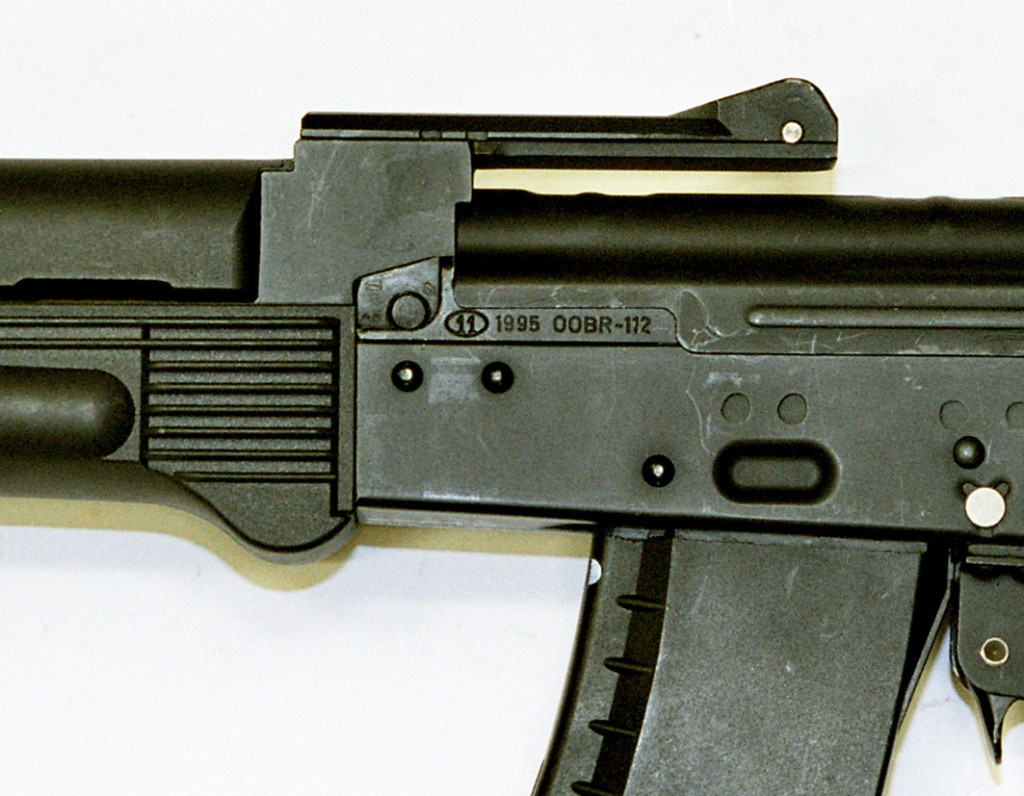
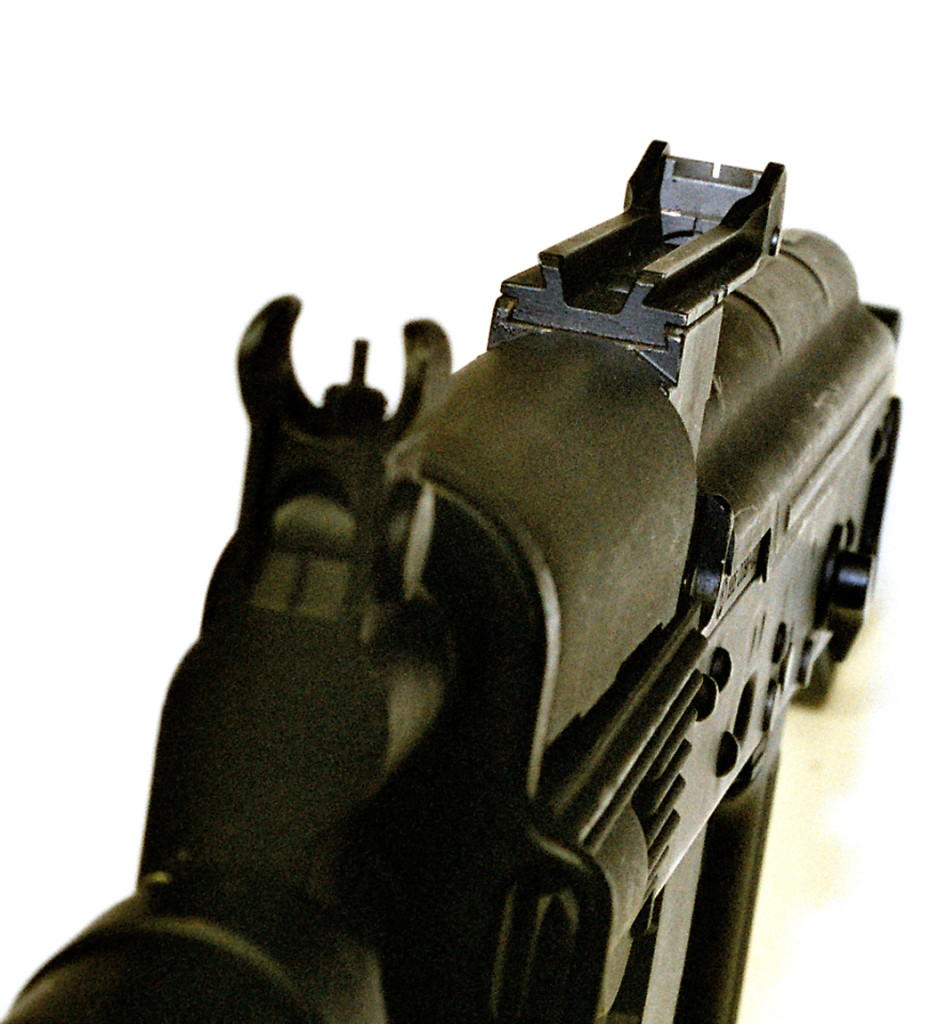
Tantalean Ordeal, The Epilogue: 5.56 mm Tantal and Onyks
Radom’s ZM Łucznik wasn’t waiting for the Warsaw Pact to tumble down with hands neatly folded. Even as the Tantal and Onyks were coming into series production, it was obvious that a 5.56 mm version would be needed – if not for the Army, then for export now that the USSR did not held an iron fist upon each export contract. As early as 1990 both Tantal and Onyks were redesigned for the 5.56 mm x 45 round, and designated respectively ‘5.56 mm kbk wz.90’ and ‘5.56 mm subkbk wz.91’. These were almost indistinguishable from the original ones, if not for the uniformly black furniture – these were in fact the first all-black Radom rifles, setting the new trend for all other products. Changing of the ammunition increased the muzzle velocity and energy just slightly, from 880 to 900 mps and from 1316 to 1620 Joules for the rifle and respectively from 700 to 710 mps and from 857 to 1010 Joules for the carbine. Despite the early success, the 5.56 mm weapons were soon discontinued – only to be re-started a few years later from the scratch, as a project codenamed ‘Beryl’, leading to adoption of the 5.56 mm kbs wz.96 Beryl – but that’s another story.
Summing up
The Tantal was by far the most original of all 5.45 mm Kalashnikov clones ever manufactured. It was the only one of them with rifle grenade capability and the only one fitted with burst limiter. Was any of these really needed or useful – that’s still open to debate, but it had them both nevertheless. It is without doubt that projects connected with small-caliber rifle and cartridge (Tantal, Onyks and Cez) gave the Polish defense industry priceless experience and self-reliance, which proved invaluable after the Warsaw Pact fell down, and a head start which enabled a fast changeover to the 5.56 mm NATO round – several years before Poland was actually accepted into the Alliance. There were however several wasted chances, mostly in the ergonomics department and sighting systems. Redesigning the AKM into a small-caliber rifle was the best chance to get rid of the complicated and expensive tangent sight, in favor of a peep. Most of the many sighting distances marked on the tangent sight leaf are simply abundant. Who would ever pick a target vulnerable to the .223 bullet at 1100 yards, much less be able to aim at it with U-notch and pin-sized front post sights?! With modern flat trajectory rounds the battle sight zero setting ‘S’ (for ‘Stały’ or permanent) enables the shooter to engage a torso target at distances up to 440 m (5.45 mm) or 460 m (5.56 mm), which in modern combat is perfectly enough for the individual fire. What are all the other distances marked for? God only knows, really, and since painting rifles in camo patterns became a fashion also in the Polish Army, one can see with a naked eye, that most sliders on these leaves were never moved – the paint on the leaf edges was never cracked. Besides, in these days iron sights are mostly of BUIS (or backup for the electro-optical sight) value anyway.

Nowadays Tantals are history in the Polish Army. After the ammunition stocks were used up, the rifles were withdrawn from the units and stored, replaced with either AKMS or Beryls. The last unit to utilize these was the Polish contingent of the UNIFIL, United Nations peacekeeping force in Lebanon, where these were basic individual weapons as late as 2004.
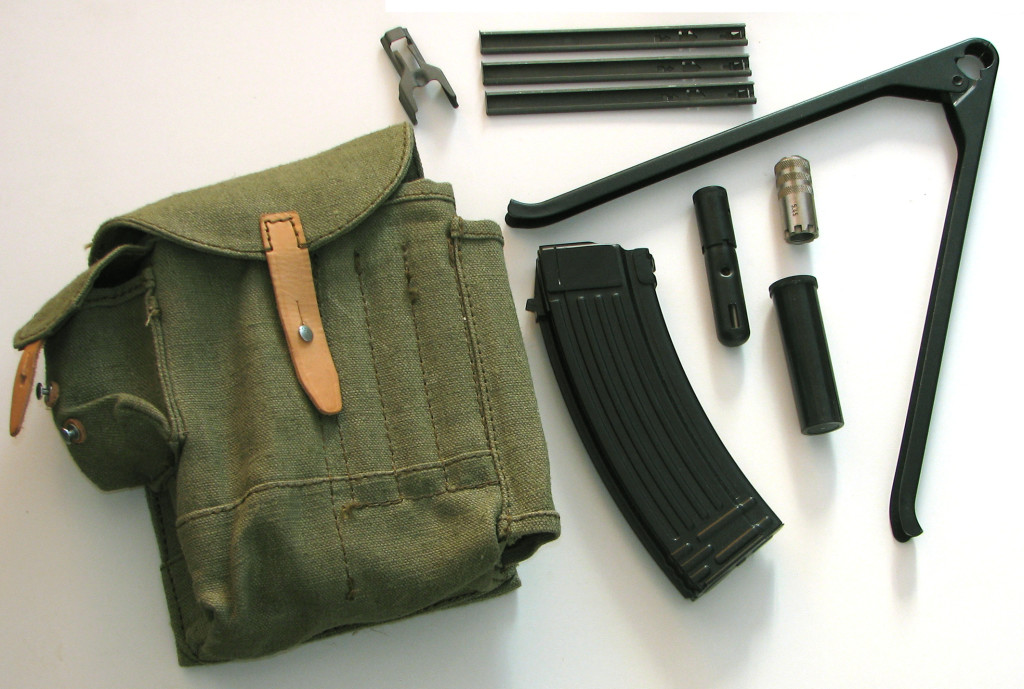
As of the 1970s, Polish small arms projects are assigned names of chemical elements, mostly metals – Wanad (vanadium), Cez (cesium), Beryl (beryllium) for codenames. Unfortunately, the anonymous civil servant, whose eye scanning the Mendeleyev Periodic Table for a fitting code, caught the name of the Group 5, Period 6, Block d metal ‘tantalum’ with the standard atomic weight of 180.9, proved to be a prophet. The history of the Polish first small-caliber rifle reflects the ordeals to which Tantalus, the mythical king of Lydia was condemned by Zeus for feeding his son’s meat to the gods. For his crimes he was to suffer the unceasing dread of being crushed by a huge rock which hung suspended above his head, he standing up to the throat in water, possessed of a terrible thirst that he could never quench, and a gnawing hunger that he tried to assuage with the tempting fruits that hung above his head, but withdrew as soon as he reached for them. Likewise, the designers of the Tantal were ever so close, yet their success was denied to them. It took them mere a year to build the rifle – but then each time they thought the goal is within reach, something happened to push their target further still. And as soon as they finally caught up with it and perfected it – no one needed it anymore.
Perhaps the final lines of Paul Anka’s famous song sung by Frank Sinatra would sum it up nicely:
For what is a man, what has he got?
If not himself, then he has naught.
The record shows I took the blows –
And did it MY WAY!

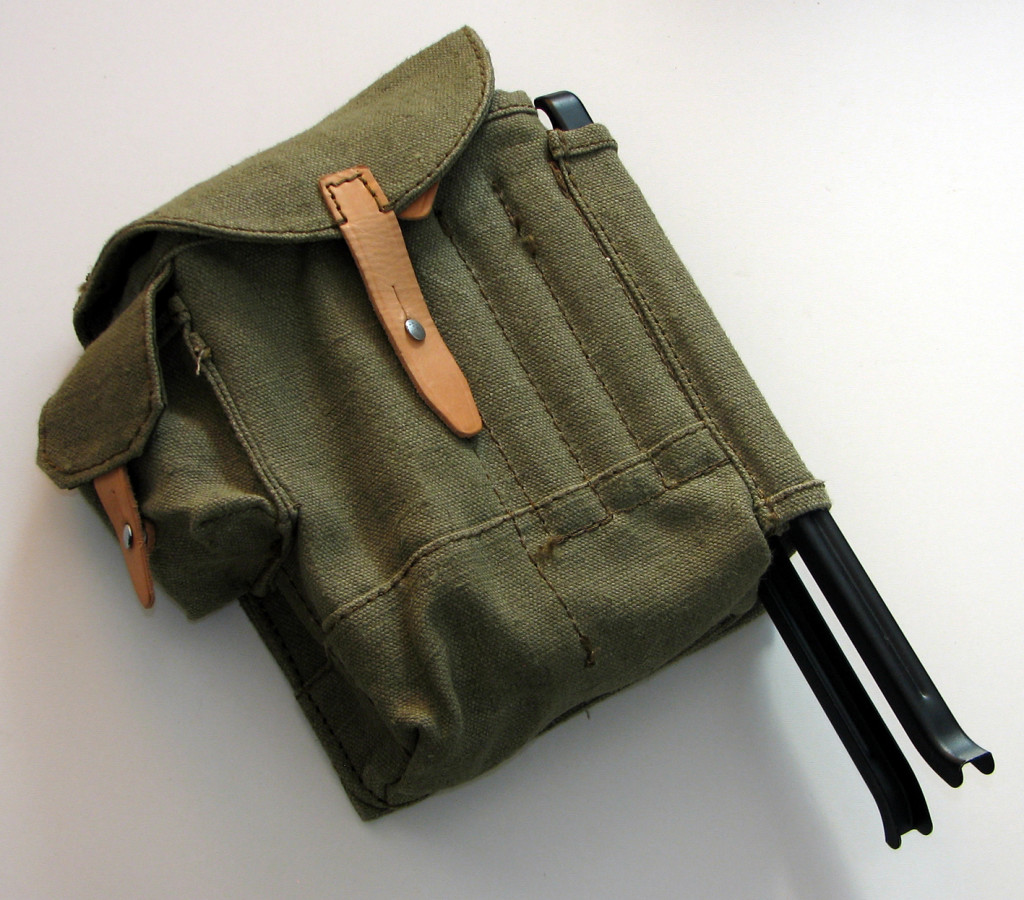

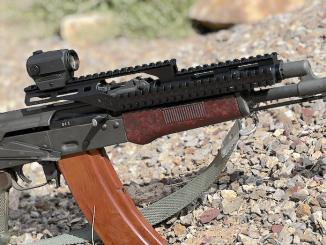
Leszek, thanks for yet another interesting Polish article! It just goes to show that nothing in adopting anything for the military is ever easy, even if it seems like it should be just a walk in the park. I’m sure even the P-38 can opener went through tons of bureaucratic nonsense.
P38 as can opener?
http://world.guns.ru/userfiles/images/handguns/germany/hg68/1287734278.jpg
Sorry Leszek for my tomfoolery in your marvellous write-up, but I just had to paste the pic from Maxim’s site for April 1st,
Bacchanalias with AK74 were conducting pretty well all nations of Warszaw pact, save for CCCP. Czecho-Slovaks in particular were originators of weapon system LADA (no relation to Russian made car) http://en.wikipedia.org/wiki/%C4%8CZ_2000
This was arguably most deviating one from master design in terms of concept and conduct. In my personal view they are as spartan and purposeful, as can be and “bad-ass’ looking to be sure.
The efforts of former WP countries small arms industries (as author of writeup correctly remarks) were not in vain; they laid foundations to capabilities which lead them to create their own ‘karabinek’, soon after fall of Berlin wall.
Denny,
The LADA/CZ2000 was in fact a deviation from Czech own national path in rifle design onto the “straight and narrow”. The rifle it was to replace, the Sa-58, was of a truly original design (striker-fired, falling block-locked, gas piston separate from bolt carrier, hold-open device, ability to load magazine in place from the striper clips), sharing only the cartridge with the AK/AKM system – while the LADA was reverting to the fold with a truly Kalashnikovian features, with just some external flavoring different.
East German MPi-74 was a whole hog licence copy of the AK-74, even to the extent of copying the triangular folding stock instead of their own Ash Poker (which was btw copied by Polish and Rumanians in their Md1986).
Sorry – the East German MPi-74S HAD the Ash Poker, my wrong.
You are quite allright Leszek, hat down. I have not much to hide and if I sounded bit ‘mysterious’, I do not mind to come clear. For one, I am familiar with vz.58 inside-out (was trained as armorer). Next, I spoke with staff in Brno who was responsible for Lada development. Finally, I know you were doing quite extensive report on CZ-805 and presented many facts in relation to its development including whoat was/ was not before; so I do not doubt extent of your knowlewdge.
Hello, Denny :
I have been following this discussion with much interest. I had not previously known that you had a background as an armorer for the vz.58 rifle, or that you had a direct involvement with the LADA / CZ-805 / CZ-2000 new-generation assault rifles. It’s great to know that we have a contributor who knows modern Czech-made weapons so intimately.
Just to add to previous, East German military (VNA) had their own version: http://www.akfiles.com/forums/showthread.php?t=4131
I spoke to someone, who was shortly after East German ‘anschus’ able to shoot their MPi74; he was VERY impressed. He said to me: this gun and the 5.45 ammo are great system!
Leszek — A very good article with plenty of interesting insights. Thanks to you, Lt.-Col. Dr. Zahor and Ian for enabling the rest of us to share in it.
Interesting how the Tantal’s original motivation was the avoid excessive licensing fees for making the AK-74. A very capitalist issue for the so-called communist nations.
There might have been other reasons and from what I read, in years between 1980-85 Russians were not very keen on passing on new technology, even to ‘brothers in arms’. For example Czechs had to literally ‘extract’ 5.45×39 chamber geometry for their AK74 version thru private contact with Russian military officer.
Let’s look at it now: a company such as Wolf makes lots of those shots for American shooters. Times have changed considerably.
Great article but I don’t get what’s all about that “civilian scum” thing…
Did i understand that correctly when it says that the original model AK-47 does not have a rate reducer on it. Reason i ask is ive always wondered how those that illegaly tamper with the rear sear on their AK47s (Dont think I have to explain to you what im talking about) keep from having out of battery detonations. Thought the rate reducer along with making it more controlable also helped keep it in time. Am i wrong about that or is it purely to for controlability.
To answer your question, it was not part of the design of the original AK-47, but was reluctantly added to the AKM during it’s development stage, out of necessity to enable it to meet accuracy standards set by the earlier rifle. Although commonly called a “rate reducer”, this was interestingly not it’s original purpose.
“Bolt bounce” amplified by the new light-weight (and more flexible) sheet metal receiver of AKM was negatively affecting accuracy to the point where the firearm would have failed initial test procedures during it’s acceptance field trials. Thus, a new assembly was devised, almost on the fly, which was technically called a “hammer retarder”. The hammer retardation system allowed the bolt to stabilize for a micro-second in battery before the hammer was released for the next shot.
According to Kalashnikov Design Bureau documents that have been published since 1989, this had a very negligible affect on the cyclic rate of fire but made for a safer firearm, as well as allowing the AKM to be as accurate as the AK-47 in automatic fire.
Thanks Leszek and Dr Zahor
a fascinating insight, and one which really highlights my own lack of knowledge of the very bushy AK family tree.
I hadn’t realized that the AK74 and AKM had so little parts interchangeability, or that the 5.45*39 had departed from the Mannlicher inherited case head size…
Lots of hows and whys for the comments thread
🙂
Interesting… But not as interesting as the fact that Avtomat Kalashnikova came out in 1841. That’s right, 1841!
http://tinyurl.com/d2bcocd
Yeah, very funny…
But what has it got to do with the subject? This link goes to a site, dealing with a book entitled “Automat” and authored by one Kalashnikov in 1841. So?
Oh, I admit… ’twas a lame diversion. But Automat… Kalashnikov. What are the odds? Oh I give up. Great article, BTW. You guys should be writing books (no pun intended).
I would like to bring one more point (and I know I occupy already so much space in this chat) to discussion. This is: what is MAJOR difference between original AK concept and current Polish and Czech fancy developments? Put it even better: why plausible and proven principles were discarded in order to follow fashionable AR/HK trends; so much more when the AK tech was so well in veins. I do not take (untrue) argument that AK is “crude and therefore obsolete”. My favored design – SIG550 is clear proof to contrary.
The etymology of ‘Krinkov’ may be obscure, but it is known – it’s a contraction of ‘Krinks’ and ‘Kalashnikov’, Krinks being the Florida gun store that built AKS-74U-style arms from parts back in the 1980s
Actually, this is a commonly repeated myth, due the this person in Florida apparently adopted the name early on after it was known in the West to be in use by the Muj in Afghanistan. This was reported as far back as the early 80’s, as stated by military journalist David Isby in SOF magazine (during the war), and in at least one of his contemporary Soviet military tactics books under the chapter on arms in use during that conflict.
Actually, a stamped receiver AK-47 most certainly does exist. 80,000 Type 1 AKs were made c1951 with a stamped body mated to a milled trunnion block, before production switched to the milled AK we know.
We captured two of those ancient Type 1s in Afghanistan in 2002, along with a cave full of ZB-26s, an English custom rifle built circa 1930 on a Mauser action, and a Canadian Ross. Not to mention a metric crap-ton of more modern AKs.
Interesting! A couple more turned up there last year, 1951-dated.
I seem to recall C.J. Chivers telling Terry Gross of NPR about this during an in-depth interview about his book, “The Gun” ( referring specifically to the AK-47,its variants and their global social, military and economic impact ) — very early production AK-47’s found or captured in Afghanistan that were externally well-worn and battered, but still reliable and fully-functional in spite of the most perfunctory maintenance. Some of these guns, along with newer ones, had apparently even been cached underwater ( and not in waterproof containers or wraps either ) in local rivers and ponds in an effort to hide them from coalition forces, and subsequently retrieved, cleaned and returned to active service.
Just to clarify my earlier comment, C.J. Chivers did not specifically mention the incident involving captured weapons you were involved in, but he did describe similar discoveries of assorted hoarded arms in the context of the interview detailing his experiences in Afghanistan as related to the history of the AK-47.
Any pics of hinged top cover (AKSU like) version of Onyks?
Badass article about an AK derivative.